

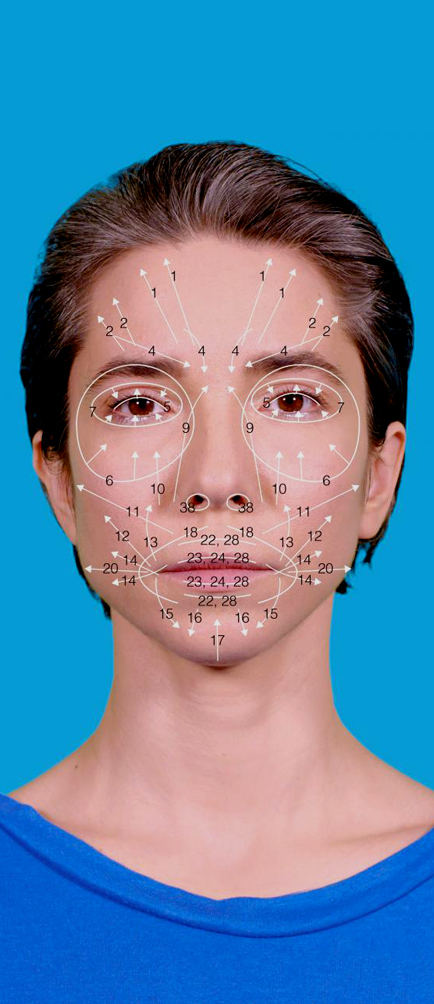
Coralie Vogelaar
Random String of Emotions
Emotion recognition software analyzes our emotions by deconstructing our facial expressions into temporal segments that produce the expression, called Action Units (AU; developed by Paul Ekman), and breaking them down into percentages of six basic emotions, happy, sad, angry, surprised, scared, and disgusted. In this video the artist uses this decoding system to turn the process around. Here – instead of detecting AUs – a computer is used to generate a random string of AUs. In this way complex and perhaps even nonexisting emotional expressions will be discovered. These randomly formed expressions, played in random order, are then analyzed again by professional emotion recognition software.

Engineered Arts
AMECA
“Multiply the power of artificial Intelligence with an artificial body. Ameca is the physical presence that brings your code to life. The most advanced lifelike humanoid you can use to develop and show off your greatest machine learning interactions. This robot is the digital interface to the real world.” Engineered Arts
.
“A U.K. robotics firm called Engineered Arts just debuted the first videos of its new humanoid robot, which is able to make hyper-realistic facial expressions. It’s a pretty stunning achievement in the world of robotics; it just also happens to be absolutely terrifying.
Named Ameca, the robot’s face features eyes, cheeks, a mouth, and forehead that contort and change shape to show off emotions ranging from awe to surprise to happiness. One of the new videos of Ameca shows it waking up and seemingly coming to grips with its own existence for the first time ever.” Neel V.Patel

Kate Cooper
Infection Drivers
Infection Drivers (2019) explores the body under attack. In this work, a CGI figure struggles to move and breathe in a translucent suit, which takes her body through transmutations of stereotypically masculine and feminine physiques as it inflates and deflates. In a time of increased public surveillance through facial-recognition software and biometric data mining, Cooper’s high-definition world invites us to investigate and perhaps find freedom in the technologies often used to constrain us.


Daniel Iregui
ANTIBODIES
ANTIBODIES est une installation interactive qui suit les visages des participants et les incite à faire des expressions faciales. La pièce reflète à quel point nous sommes absents et détachés lors des appels vidéo – la forme aujourd’hui imposée de rassemblements sociaux. À la fin de chaque expérience, toutes les interactions deviennent partie d’une galerie d’êtres humains désincarnés.
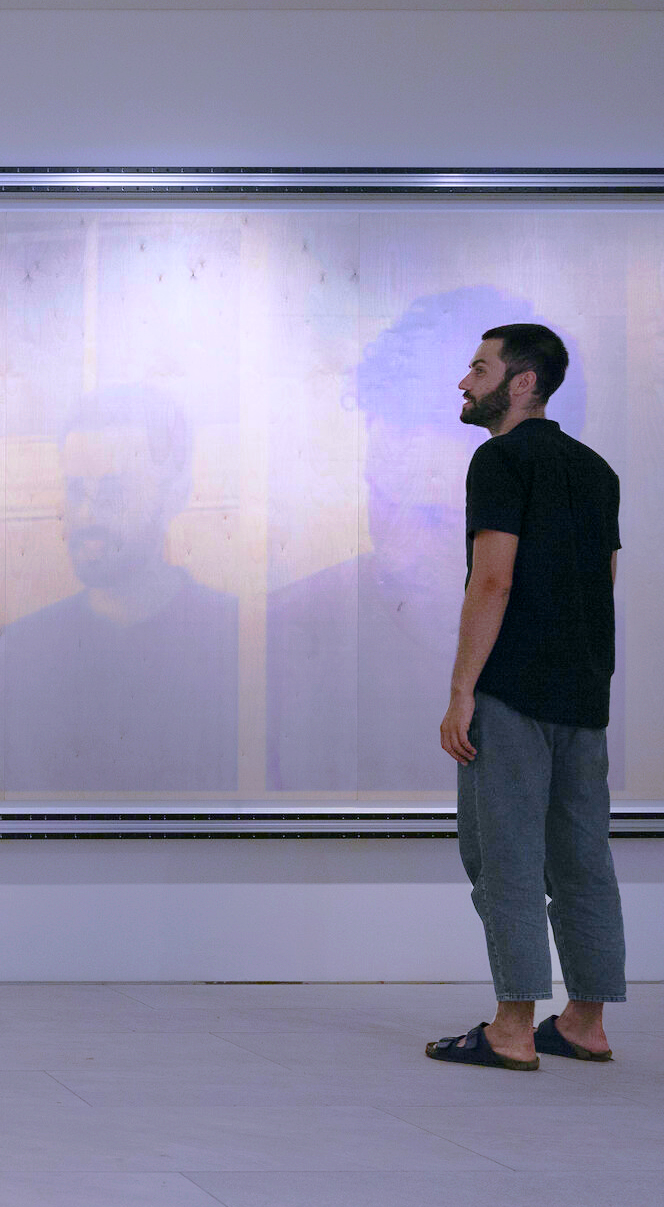
Random International
Presence and Erasure
Presence and Erasure is a portrait machine that explores the reality of automated facial recognition and how people relate to their self-image, instinctively and emotionally. Within a given spatial domain, the artwork constantly scans for faces in the vicinity and photographs them. When the artwork’s algorithm detects a certain quality within a photograph, this image is temporarily printed at large scale by exposing a photochromic surface to light impulses. Each automated portrait remains for little more than a minute, before gradually dissolving into blankness. RANDOM INTERNATIONAL began to combine transient mark-making with automated portraiture early on in their practice, in 2008. Presence and Erasure marks the latest development in this body of work and assumes a minimal, industrial aesthetic that references their earliest studies on this theme. The physical impact of facial recognition and machine vision is emphasised by the exposure of the printing process itself, contrasted against the aesthetic of the high resolution portraits generated. RANDOM INTERNATIONAL intend this as a counter to the perception of surveillance footage as always being low quality, aiming to create a deeper reflection on the nature of surveillance today as well as the resounding cognitive and emotional dissonances.

Hiroshi Ishiguro Lab and Dr Dylan Glass
Erica
ERICA EST DÉVELOPPÉ POUR UNE PLATEFORME DE RECHERCHE POUR LE ROBOT CONVERSATIONNEL AUTONOME QUI PEUT COMMUNIQUER AVEC LES PERSONNES DE DIVERSES FAÇONS TELLES QUE LA VOIX, LES GESTES CORPORELS, LES EXPRESSIONS FACIALES, LE CONTACT VISUEL ET LE TOUCHER. L’APPARENCE D’ERICA EST FAITE EN CG CONÇU POUR AVOIR LES CARACTÉRISTIQUES QUE LES BEAUX VISAGES ONT. LA VOIX EST GÉNÉRÉE PAR LA TECHNOLOGIE TEXTE-PAROLE DE LA PLUS HAUTE QUALITÉ. LES ACTIONNEURS PNEUMATIQUES DÉPLACENT SON CORPS DOUCEMENT AVEC UN PETIT BRUIT SEULEMENT. L’OBJECTIF DE L’ÉTUDE EST DE CRÉER DES ANDRODES CONVERSATIONNELS AUTONOMES QUI PEUVENT INTERAGIR NATURELLEMENT AVEC LES GENS ET S’IMPLIQUER SOCIALEMENT DANS LA VIE QUOTIDIENNE.

胡帅
Synesthesia Machine
“Synesthesia Machine” is an artificial intelligence with synesthesia, it will emitting corresponding unique scents while perceiving human facial expressions. Through the facial expression recognition algorithm, it can analyze the facial expressions of the audience and output the values of different emotions. At the same time, based on these emotional values, the installation is driven to extract different proportions of scent liquid and atomized and mixed to convert the audience’s facial expression into a unique smell.

c-lab
Tech Camouflage: Anti-Facial Recognition.
Model: Kim Jeong Eun
In order to help understand the main discourses covered by the project and to explore various interpretations on the theme of * c-lab 1.0, ‘Beauty, familiar familiarity’, we conducted a “Technology camouflage: anti-facial recognition technology make-up workshop” as a linked program. . Recognizing that facial recognition technology that is widely used with the generalization of smartphones and SNS can also be used as a way to monitor and control individual freedom, as a new form as an alternative to protect personal privacy from such technologies This is a workshop program that has practiced make-up and hairstyle.

HYE YEON NAM
Please Smile
File Festival
“Please smile” is an exhibit involving five robotic skeleton arms that change their gestures depending on a viewer’s facial expressions. It consists of a microcontroller, a camera, a computer, five external power supplies, and five plastic skeleton arms, each of them with four motors. It incorporates elements from mechanical engineering, computer vision perception, to serve artistic expression with a robot.

Rafael Lozano Hemmer
Redundant Assembly
In “Redundant Assembly” an arrangement of several cameras composes a live-portrait of the visitor from six perspectives simultaneously, aligned using face detection. The resulting image is uncanny, detached from the laws of symmetry and the depth perception of binocular vision. If several visitors are standing in front of the work, a composite portrait of their different facial features develops in real time, creating a mongrel “selfie”.

Klaus Obermaier
Face IT
The interactive installation FACE IT displays and exposes local people in a communicative setting where they are able to interact with faces of themselves or of other participants and at the same time become creative players and the stars of the artwork. This interactive situation not only creates a strong interplay between facial expressions and body movements, it also enhances these expressions and in the very best moments it creates a unique nonverbal language.
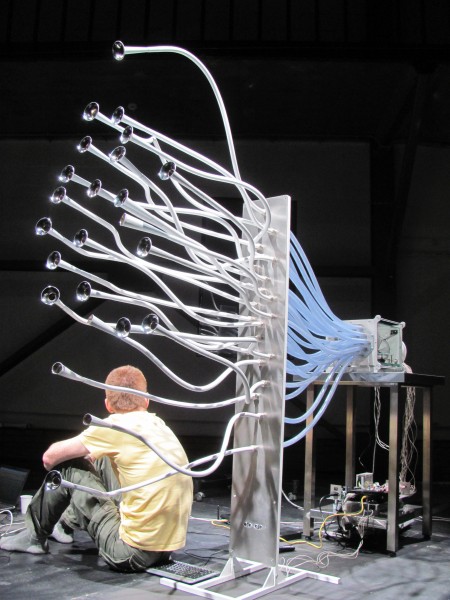
Where Dogs Run
Smell of faces
This unique, ever-changing pattern is visualized in a facial composite. This is how it works: when a person approaches the analyzer, sniffing tubes “sniff” him, then gas analyzers process the information, which then passes to a computer program that translate air composition data into data concerning the shape and position of facial features (the components of a facial composite). As a result, a person sees a face of their smell that is conditional, in no way related to their actual physical appearance.

jip van leeuwenstein
surveillance exclusion
Camera’s and other technologies create a safer living environment than ever before. Mega databanks and high resolution cameras stock hundreds of exabytes a year. But who has access to this data? Not only the security department but also the advertisement industry is interested in this technology. They pay to use real time data to their advantage. They create advertisements that call your name, keep records of your personal interests and they follow you everywhere you go. By wearing this mask formed like a lens it possible to become unrecognizable for facial recognition software and because of it’s transparence you will not lose your identity and facial expressions. So it’s still possible to interact with the people around you.
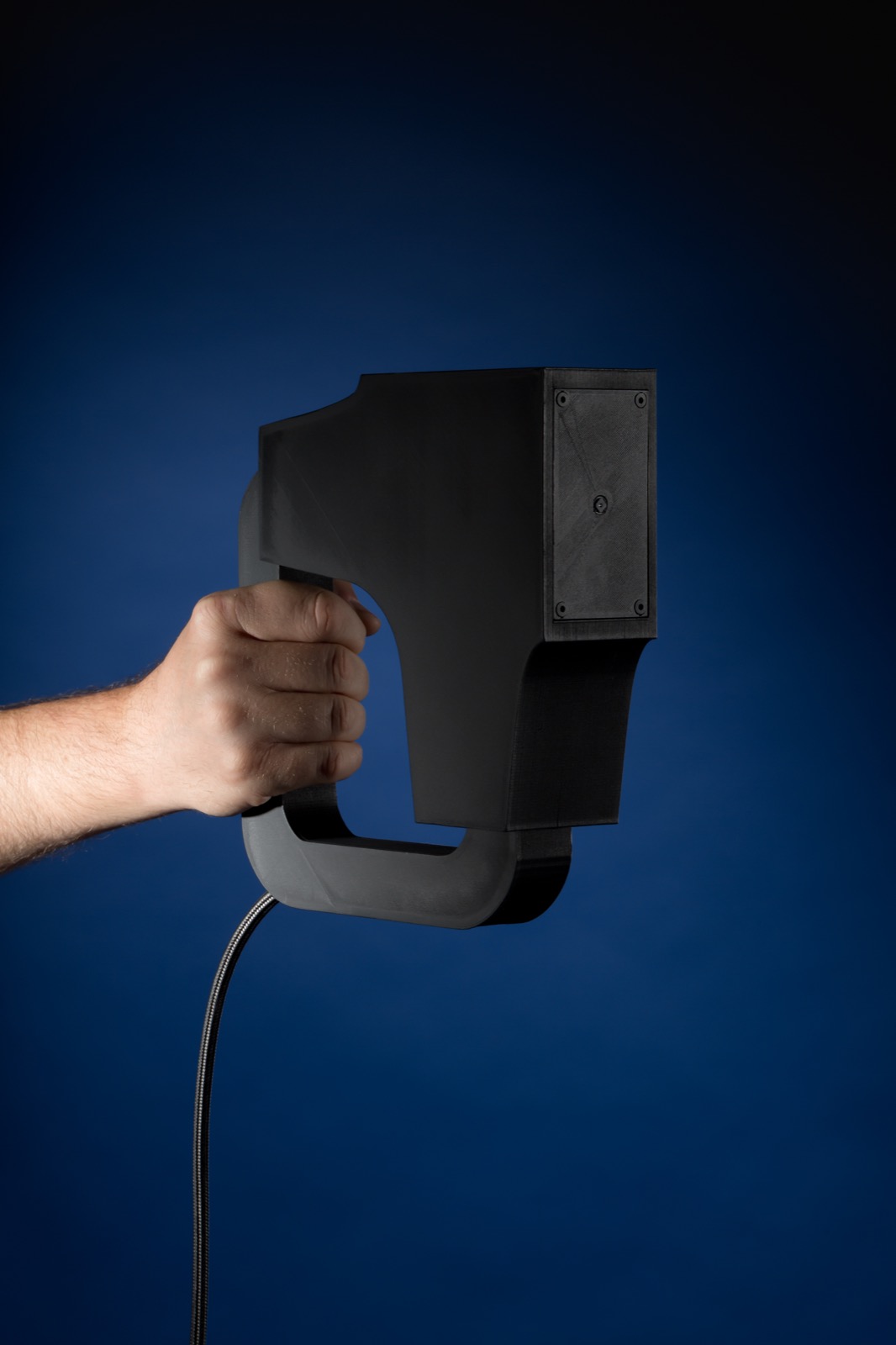
Marta Revuelta
AI Facial Profiling, Levels of Paranoia
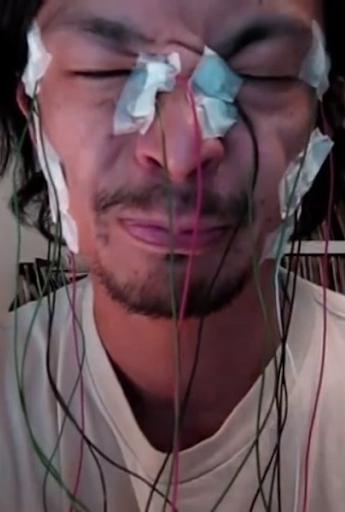
DAITO MANABE
真鍋 大 度
One of the new technology projects from the programmer and artist Daito Manabe based in Tokyo, Japan, centres on experimental music performances and connects a person’s face to electric sensors. This innovative system lets you ‘play’ your face like a musical instrument with the help of facial movements that trigger sounds. Electrical stimulation makes a face twitch involuntary, each twitch matches the beat of the music.
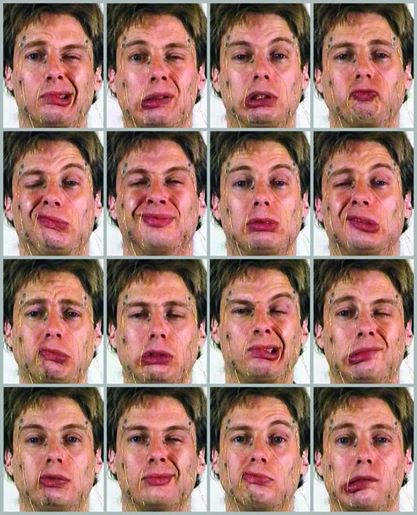
ARTHUR ELSENAAR
The Varieties of Human Facial Expression
12 bit version
“The Varieties” is an algorithmic exploration of human facial expression. Six muscles on each side of the face are triggered in succession by means of electrical stimulation, resulting in 4096 different facial expressions.

bernd hopfengaertner
BELIEF SYSTEMS
Facial micro expressions last less than a second and are almost impossible to control. They are hard wired to the emotional activity in the brain which can be easily captured using specially developed technological devices. Free will is now in question as the science exposes decision-making as an emotional process rather than a rational one. This ability to read emotions technologically result in a society obsessed with their emotional reactions. Emotions, convictions and beliefs which usually remain hidden, now become a public matter. “Belief systems” is a video scenario about a society that responds to the challenges of modern neuroscience by embracing these technological possibilities to read, evaluate and alter peoples behaviours and emotions.

hanson robotics
Sophia the robot
Sofia, le robot humanoïde (android) ultra-réaliste fabriqué par Hanson Robotics, devient le premier robot a obtenir une citoyenneté officielle ! C’est l’Arabie Saoudite qui a officialisé il y a quelques jours l’existence de Sofia, devenant le premier pays à reconnaitre le statut de citoyen d’un robot et d’une intelligence artificielle. Sofia, dont nous avions déjà parlé l’année dernière, est un robot ultra-réaliste capable de tenir une conversation, de reconnaitre les gens et d’interagir avec son environnement, mais surtout possède sa propre personnalité et des expressions faciales réalistes.
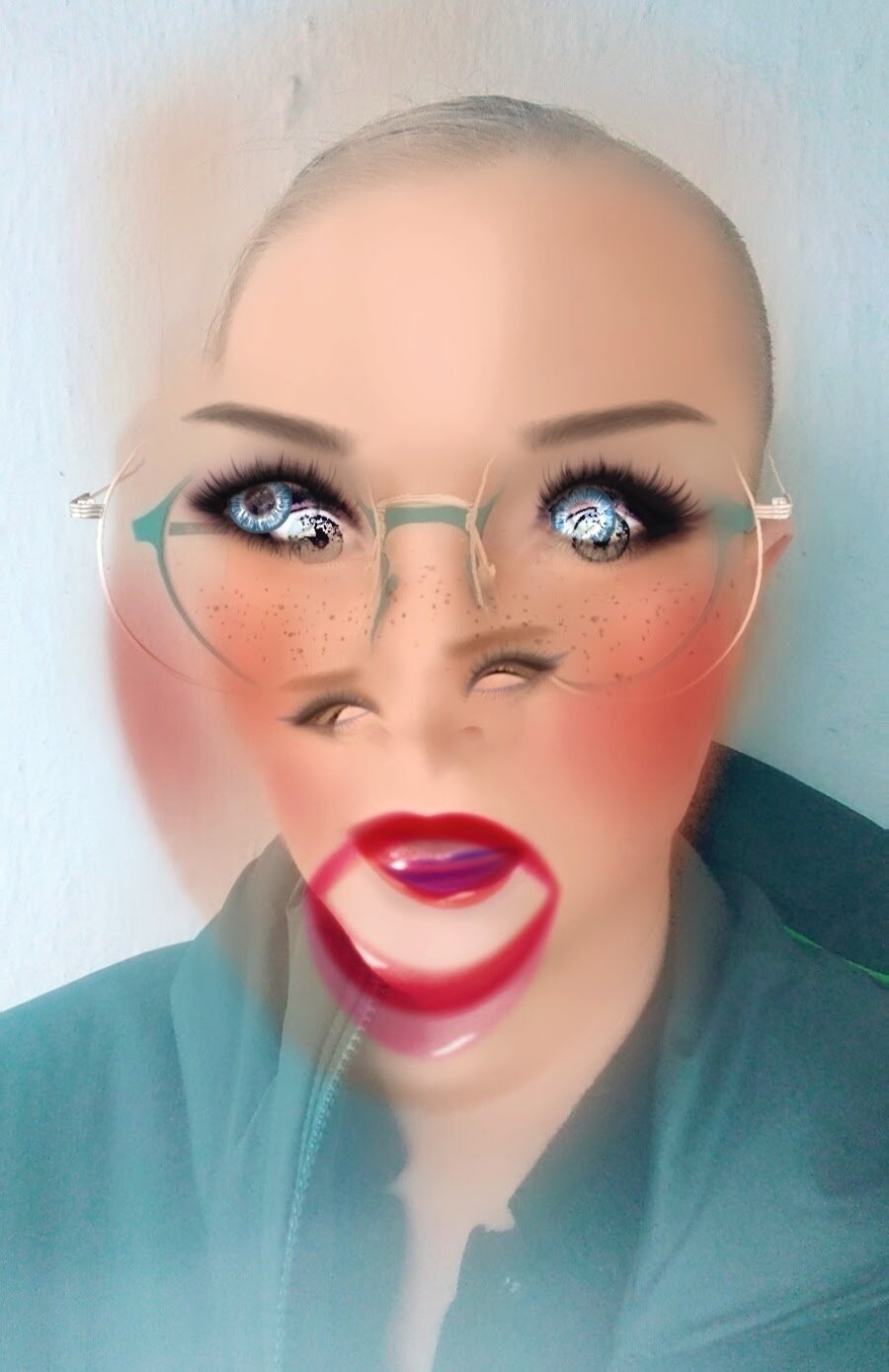
M. Eifler
The Masking Machine
Using a custom wearable computer I can walk around any space wearing the still images now animated by my facial expressions. When seen through the screen hovering in front of my face I wear the images like an avatar, but unlike with the stills on a wall or images online I can reach out from behind the screen to shake hands and talk with viewers.

Ronald Stoops
Although fashion photography often uses intense facial expressions to complement exquisite styles and tell intricate stories, Ronald Stoops does just the opposite. Shielding the face through various mediums, he relies on his models fluid movement, extravagant costuming and appropriately eerie settings to get his message across.

adi meyer
Aposema:Responsive Facial Prosthesis
In an age of emotion recognition algorithms and augmented realities, our overuse of personal devices and social media, has led to a society where people increasingly choose technological alternatives to meaningful in-person interaction. Our ability to read facial expressions is severely reduced, limiting our capacity to develop relationships and leaving us struggling to empathize.

Lucy McRae
Biometric Mirror exposes the possibilities of artificial intelligence and facial analysis in public space. The aim is to investigate the attitudes that emerge as people are presented with different perspectives on their own, anonymised biometric data distinguished from a single photograph of their face. It sheds light on the specific data that people oppose and approve, the sentiments it evokes, and the underlying reasoning. Biometric Mirror also presents an opportunity to reflect on whether the plausible future of artificial intelligence is a future we want to see take shape.

BRUNO METRA AND LAURENCE JEANSON
برونو مترا وجينسون لورانس
Бруно Метра и Лоренс Джинсон
Talented French duo of photographers Bruno Metra and Laurence Jeanson experiments with our visual perception. Using sticky tape, cuts from fashion magazines and human portraits they create a new form of facial expressions. After watching few works in a row your mind starts working as usual and you easily adopt the new transformed face as it is.
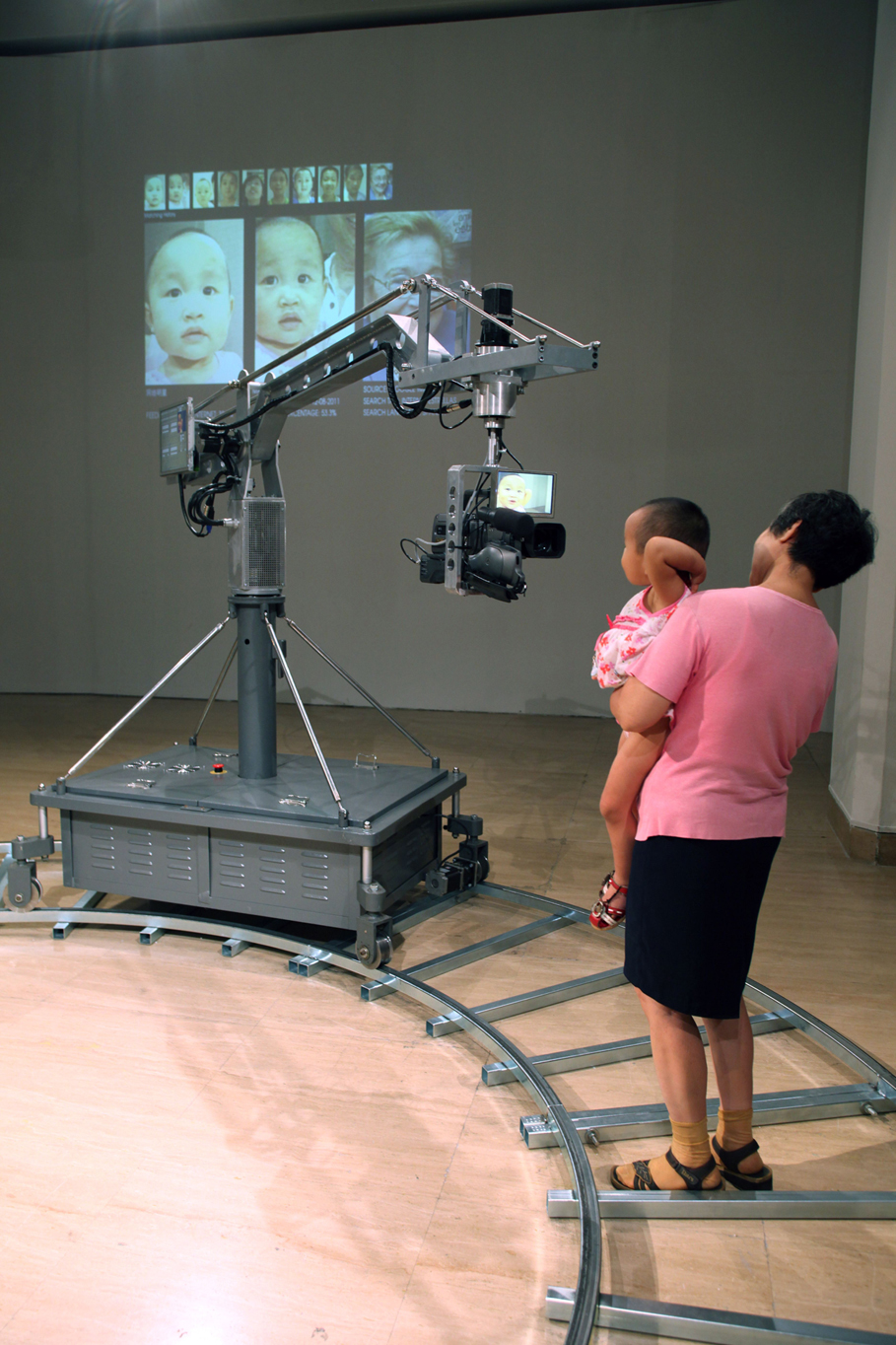
Marnix de Nijs
15 Minutes of Biometric Fame
The design of the installation 15 Minutes of Biometric Fame is inspired by the camera dollies employed in the television and cinema industries. A camera crane moves autonomously over a large circular track. In a rather intimidating manner, it points the camera at visitors in the exhibition space and scans each visitor’s facial features, comparing them to those of a vast array of preselected persons in a database.

Tim Coe
A Perfect Face
File Festival
The starting point is super-model Claudia Schiffer, however, the facial features are in a state of flux, ‘mutating’ every few seconds to a new configuration

Laura Splan
Gloves
Laura Splan’s work examines the material manifestations of our cultural ambivalence towards the human body. Her conceptually based projects employ a range of traditional and new media techniques. She often uses found objects and appropriated sources to explore socially constructed perceptions of order and disorder. Much of her work is inspired by experimentation with materials and processes including blood, cosmetic facial peel and digital fabrication.
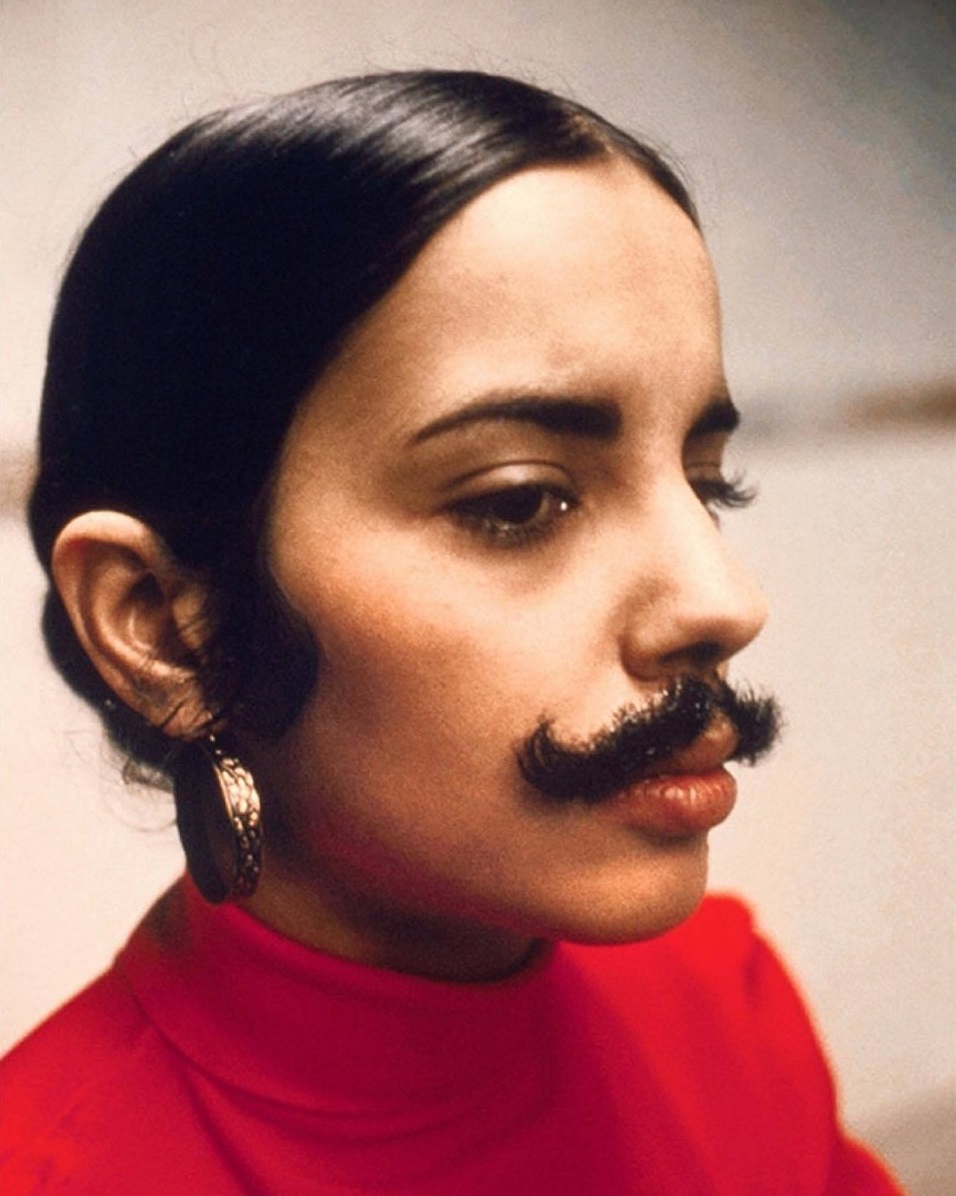

zach blas
Facial Weaponization Suite
Die Facial Weaponization Suite protestiert gegen die biometrische Gesichtserkennung – und die Ungleichheiten, die diese Technologien verbreiten -, indem sie in Community-basierten Workshops „kollektive Masken“ erstellt, die aus den aggregierten Gesichtsdaten der Teilnehmer modelliert werden. Dies führt zu amorphen Masken, die von Menschen nicht als menschliche Gesichter erkannt werden können biometrische Gesichtserkennungstechnologien. Die Masken werden für öffentliche Interventionen und Aufführungen verwendet. Eine Maske, die Fag-Gesichtsmaske, die aus den biometrischen Gesichtsdaten vieler queerer Männergesichter generiert wird, ist eine Antwort auf wissenschaftliche Studien, die die Bestimmung der sexuellen Orientierung durch schnelle Gesichtserkennungstechniken verbinden. Eine andere Maske untersucht eine dreigliedrige Vorstellung von Schwärze, die zwischen biometrischem Rassismus (der Unfähigkeit biometrischer Technologien, dunkle Haut zu erkennen), der Bevorzugung von Schwarz in der militanten Ästhetik und Schwarz als dem, was informell verschleiert, aufgeteilt ist. Eine dritte Maske befasst sich mit den Beziehungen des Feminismus zu Verschleierung und Unmerklichkeit und betrachtet die jüngste Schleiergesetzgebung in Frankreich als einen beunruhigenden Ort, der Sichtbarkeit zu einer unterdrückenden Kontrolllogik macht. Eine vierte Maske greift den Einsatz von Biometrie als Grenzsicherungstechnologie an der mexikanisch-amerikanischen Grenze und die daraus resultierende Gewalt und den damit verbundenen Nationalismus auf. Diese Masken überschneiden sich mit der Verwendung von Maskierung durch soziale Bewegungen als undurchsichtiges Werkzeug der kollektiven Transformation, das dominante Formen politischer Repräsentation ablehnt.

Tim Coe
Perfect face
FILE FESTIVAL
The viewer is confronted with a face on the screen that is constantly, almost imperceptibly changing. The perfect hair and make-up give rise to the expectation of a beautiful model, but this is not always fulfilled. The starting point is super-model Claudia Schiffer, however, the facial features are in a state of flux, ‘mutating’ every few seconds to a new configuration. Our reaction to the face changes accordingly between attraction and repulsion. Beauty has long established itself as a commodity that can be sold and bought. ‘A PERFECT FACE’ constantly tests and challenges our idea of what beauty is.

KYLE MCDONALD
Face Substitution
Faces is an interactive installation result of the work on face substitution in collaboration with Arturo Castro
“The installation is based on the idea of wishing for a new identity: when the subject first steps up, they see their face unmodified. After closing their eyes to make a wish and opening them again, they discover they are wearing a new face. The result is a mixture of a playful, surprising and some times scary experience.This installation takes advantage of the unique experience of slowly recognizing yourself as someone else playing also with the concept of the uncanny valley by showing a face that perfecly matches the visitors facial expresion but still has some lighting and texturing imperfections. This elicits everything from laughter, to surprise, or repulsion.Knowing that it takes approximately one second for someone to respond to a completely unexpected event, we store a photograph at 1.5 seconds after the swap — capturing that moment of realization.”Arturo Castro

KLAUS WEBER
كلاوس ويبر
克劳斯·韦伯
클라우스 베버
Клаус Вебер
32 death masks
32 death masks grew out of Weber’s fascination with a practice traditionally performed in Western societies, whereby facial impressions of recently deceased persons are made in plaster. Prior to the invention of photography, the act of producing casts or “masks” from these molds was undoubtedly the most accurate way of preserving a particular person’s visage for viewing long after their death.